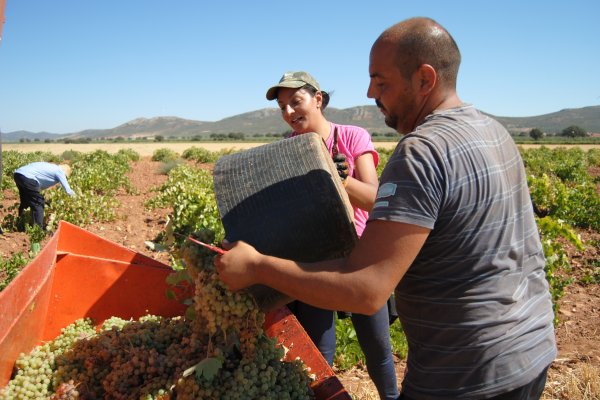
First prices for grapes 2022/23 in Castilla-La Mancha, in a year without public «tablets» in Valdepeñas
The 2022/2023 campaign that started last August 1 may be the first in which none of the two big producers of Castilla-La Mancha (Félix Solís and Vinartis-García Carrión) hang the traditional «tablets» with the prices at which they buy the grapes publicly at their production sites in Valdepeñas and refer only to the individual contracts they conclude with each of their suppliers. A practice already carried out in previous campaigns Vinartis-García Carrión and adopted in 2022/23 Félix Solís.
Therefore, to refer to the first prices for new grapes we have to resort to the private contracts that SeVi has been able to access. According to these documents, Félix Solís would initially be paying the fruit of the harvest 2022/23 in its center of Valdepeñas at the following prices:
For the white variety Airén pays 0.017429 euros per kilograde (2.90 pesetas/kgdo).
For the ink Tempranillo/Cencibel liquidates 0.19232 euros per kilograde (3.20 pesetas/kgdo).
This important winemaking group also offers two bonuses for the Tempranillo variety. On the one hand, it pays 60% more than the indicated base price if the consignment of Tempranillo is destined for the elaboration of wine with D.O.P. Valdepeñas. On the other hand, it adds a bonus of 0.06 euros per kilogram of grapes (9.98 euros per kilo) in the case of grapes harvested by hand.
At the moment, the contracts to which SeVi has acceded do not include bonuses for the Airén variety.
According to SeVi, Felíx Solis is also paying winegrowers a plus of 2 pesetas per kilo, as freight.
They have also begun to transcend contracts of this winery group for batches of varietals. Thus, the transactions to which this journal has been able to access collect the following quotes (base price):
For the white variety Chardonnay: 0.036061 euros per kilograde (6.00 pesetas).
For the variety ink Syrah: 0.019833 euros per kilodegree (3.30 pesetas).
It should be noted that the Wine Sector Council of Agro-food Cooperatives issued its production estimate, which comes to slightly update the estimate a few weeks ago by Agro-food Cooperatives of CastileLa Mancha and that was already advanced by the SeVi. The organization estimates for the whole of Spain that the production of wine and must of the newly started season 2022/23 could be around 36.3 million hectolitres, with a decrease of 9.1% and 3.6 million in relation to production in the 2021/22 period, and 13.6% and 5.7 million compared to the average of the last five years (2017-2021). Castilla-La Mancha would concentrate more than 55% of the national wine production in 2022/23, with about 20 Mhl, which is almost 12% lower than the last season (almost 22.7 Mhl) and is also 16.6% and about 4 million below the average (23.97 Mhl) of the previous five-year period 2017-2021.
Regarding prices and contracts for the purchase/sale of grapes, the agricultural organization Asaja in Castilla-La Mancha considers that the law on the food chain turns against the winegrower because some industries impose these contracts on producers «under the threat of not buying their grapes». The Food Chain Act provides that food contracts, in addition to the obligation to reflect the price of all payments, must contain that the price agreed between the producer and its first buyer covers the actual cost of production.
According to the secretary general of Asaja-CLM «this is not happening, because there are companies that, to take the grapes from the farmer, are demanding that they sign a paper establishing what are their costs and even making them deliver the grapes without price».
In this sense, Fresneda has pointed out that «it cannot be that the same thing happens every year and that it is the industry that moves 15% of the wine in the region that sets the rules of the game, when 85% of the production is in the hands of the cooperatives».
According to Asaja, the conditions exist for prices to rise, since the estimates point to a significant reduction in the harvest of the main producing countries, such as France, Italy or Portugal, as well as in Spain and CastileThe Channel which, as the days go by, shows even more the decrease in production. Market conditions are also favourable, as operations are taking place in countries such as France and Italy that are buying at prices higher than last year, and, in addition, stocks are the lowest in the last decade and domestic consumption in Spain has grown.
SOURCE: SEVI.NET
